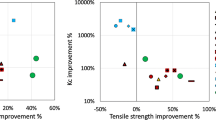Abstract
Ambient, amine-cured epoxy compositions exist within the dual constraints of VOC regulation and the vitrification effect, which limits the ultimate T g of these materials. These combined constraints result in epoxy products that are densely crosslinked and which contain appreciable quantities of nonfugitive diluents or plasticizers. Such materials tend to be more brittle than traditional solvent-based epoxy coatings based on solid epoxy resin and polyamide hardeners. There is thus a need for a practical method to measure their fracture toughness. This work introduces the method of essential work as a useful way to determine the fracture toughness of thermoset systems. This method is then used to relate fracture toughness to the crosslink network structures of amine-cured epoxy compositions. The test compositions are varied systematically with a view to structure/properties interpretation, and employ an in situ chain extension approach to “grow” more ductile networks. Solvent uptake of selected compositions is also determined, and the relative trade-off between ductility vs. solvent uptake is examined.






Similar content being viewed by others
References
Gillham, JK, “Cure and Properties of Thermosetting Polymers.” In: Kinloch, AJ (ed.) Structural Adhesives: Developments in Resins and Primers, pp. 1–27. Elsevier Applied Science Publishers, London (1986)
Pfaff, FA, “Mechanical Relaxation Effects in Amine Cured Epoxies.” In: Proc. SPI Epoxy Resin Formulators Conference, New Orleans, LA, Nov 3–5 (1996)
Yee AF, Pearson RA Toughening Mechanisms in Elastomer-Modified Epoxies, Part 1, Mechanical Studies. J. Mater. Sci. 21, 2462–2474 (1986)
Pearson RA, Yee AF Toughening Mechanisms in Elastomer-Modified Epoxies, Part 2, Microscopy Studies. J. Mater Sci. 21, 2475–2488 (1986)
Pearson RA, Yee AF Toughening Mechanisms in Elastomer-Modified Epoxies, Part 3, The Effect of Crosslink Density. J. Mater. Sci. 24, 2571–2580 (1989)
Pearson RA, Yee AF Influence of Particle Size and Particle Size Distribution on Toughening Mechanisms in Rubber-Modified Epoxies. J. Mater. Sci. 26, 3828–3844 (1991)
Cardwell BJ, Yee AF Toughening of Epoxies Through Thermoplastic Crack Bridging. J. Mater. Sci. 33, 5473–55484 (1998)
Yee AF, Li D, Li X, The Importance of Constraint Relief Caused by Rubber Cavitation in the Toughening of Epoxy. J. Mater. Sci. 28, 6392–6398 (1993)
Kinloch AJ, Hunston DL Effect of Volume Fraction of Dispersed Rubbery Phase on the Toughness of Rubber-Toughened Epoxy Polymers. J. Mater. Sci. Lett. 6, 137–139 (1987)
Huang Y, Kinloch AJ The Role of Plastic Void Growth in the Fracture of Rubber-Toughened Epoxy Polymers. J. Mater. Sci. Lett. 11, 484–487 (1992)
Huang Y, Kinloch AJ Modelling of the Toughening Mechanisms in Rubber-Modified Epoxy Polymers. J. Mater. Sci. 27, 2763–2769 (1992)
Xiao K, Ye L Rate-Effect on Fracture Behavior of Core-Shell-Rubber (CSR)-Modified Epoxies. Pol. Eng. Sci. 40, 70–81 (2000)
Xiao K, Ye L Effects of Rubber-Rich Domains and the Rubber-Plasticized Matrix on the Fracture Behavior of Liquid Rubber-Modified Araldite-F Epoxies. Pol. Eng. Sci. 40, 2288–2298 (2000)
D5045, Amer. Soc. Test. Mater., 08.02
E1820, Amer. Soc. Test. Mater., 03.01
Nichols ME, Darr CA, Smith CA, Thouless MD, Fischer ER Fracture Energy of Automotive Clearcoats – I. Exp Methods Mech. Poly. Degrad. Stab. 60, 291–299 (1998)
Nichols ME, Gerlock CA, Smith CA, Darr CA The Effects of Weathering on the Mechanical Performance of Automotive Paint Systems. Prog. Org. Coatings, 35, 153–159 (1999)
Nichols MEJ Anticipating Paint Cracking: The Application of Fracture Mechanics to the Study of Paint Weathering. JCT, 74(924), 39 (2002)
Nichols ME Using Fracture Mechanics to Characterize Organic Coatings. JCT CoatingsTech, 2(21), 62–67 (2005)
Cotterell B, Reddel JK The Essential Work of Plane Stress Fracture. Int. J. Fract. 13, 267–277 (1977)
Mouzakis DE, Gahleitner M, Karger-Kocsis J Toughness Assessment of Elastomeric Polypropylene (ELPP) by the Essential Work of the Fracture Method. J. Appl. Pol. Sci. 70, 873–881 (1998)
Karger-Kocsis J, Moskala EJ Molecular Dependence of the Essential and Non-Essential Work of Fracture of Amorphous Films of poly(ethylene-2,6-naphthalate) (PEN). Polymer 41, 6301–6310 (2000)
Mai Y-W, Powell P Essential Work of Fracture and J-Integral Measurements for Ductile Polymers. J. Polym. Sci. Phys. B, 29, 785–793 (1991)
Wu J, Mai Y-W The Essential Fracture Work Concept for Toughness Measurement of Ductile Polymers. Pol. Eng. Sci. 36(18), 2275–2288 (1996)
Fasce L, Bernal C, Frontini P, Mai Y-W On the Impact Essential Work of Fracture of Ductile Polymers. Pol. Eng. Sci. 41(1), 1–13 (2001)
Light ME, Lesser AJ Effect of Test Conditions on the Essential Work of Fracture in Polyethylene Terephthalate Film. J. Mater. Sci., 40, 2861–2866 (2005)
D792, Amer. Soc. Test. Mater., 08.01
Miller DR, Macosko CW A New Derivation of Post Gel Properties of Network Polymers. Macromolecules 9, 206–211 (1976)
Lesser AJ, Kody RS A Generalized Model for the Yield Behavior of Epoxy Networks in Multi-axial Stress States, J. Polym. Sci., Polym. Phys., 35, 1611–1619 (1997)
E1356, Amer. Soc. Test. Mater., 14.02
D638, Amer. Soc. Test. Mater., 08.01
Pascault J-PSautereau H, Verdu J, Williams RJJ, Thermosetting Polymers, Marcel Dekker, New York, p. 369 (2002)
Acknowledgments
The author wishes to thank Prof. Alan Lesser of the University of Massachusetts, Amherst, for introducing the method of essential work of fracture to us and for providing invaluable guidance; also, Fred Gelfant of Stonhard for many helpful suggestions; and Matthew Rossi for his excellent laboratory work.
Author information
Authors and Affiliations
Corresponding author
Additional information
This article was awarded the Outstanding Paper Award in New Coatings Technology at the 33rd Annual International Waterborne, High-Solids, and Powder Coatings Symposium in New Orleans, LA, February 2006, and was presented at the Thermoset Resins Formulators Association Conference in Montreal, Quebec, Canada, September 2006.
Rights and permissions
About this article
Cite this article
Pfaff, F.A. Growing more ductile epoxies: an essential work of fracture study. J Coat Technol Res 4, 151–159 (2007). https://doi.org/10.1007/s11998-007-9013-4
Published:
Issue Date:
DOI: https://doi.org/10.1007/s11998-007-9013-4




